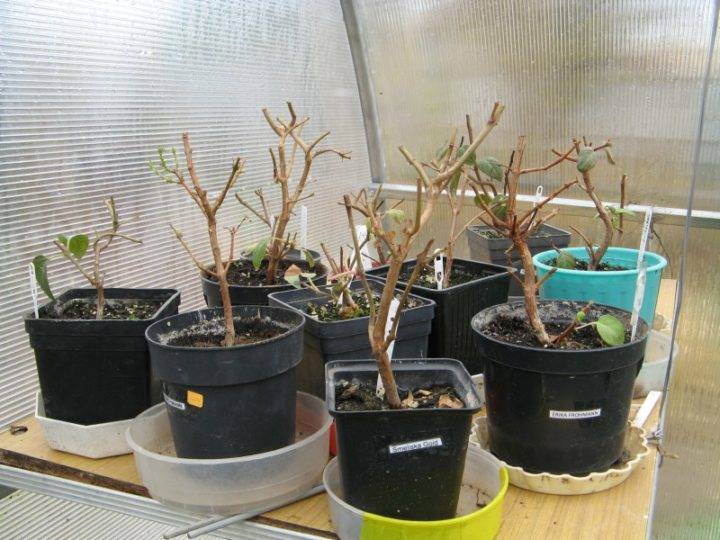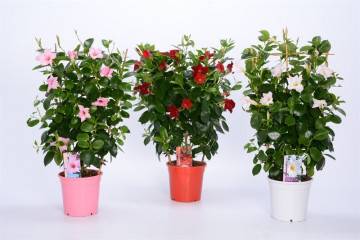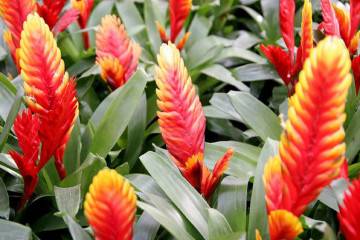Fuchsia - growing and care at home
Content:
Fuchsia is in the flower collection of many gardeners. This is a long-known flower, loved by many. It attracts attention due to its long flowering.
What does it look like, which family it belongs to
This plant belongs to the Fireweed family. There are several types of fuchsias:
- tree-like;
- shrub;
- with drooping stems;
- with erect stems.
There are many varieties of this plant, and each is good in its own way, for example, Annabel and Marinka. They differ from each other in color and size of flowers, shape and size of leaves.
The homeland of decorative fuchsia is Central and South America, as well as New Zealand. The ancient Aztecs ate its fruits. She came to our country 200 years ago through England.
Fuchsia: growing and care at home
Growing and caring for this plant at home is suitable even for novice florists. Although there are many varieties, the care for them is about the same.
Temperature
The best temperature for proper growth and development in summer is 18-20 degrees. The plant does not tolerate high temperatures. If possible, in the summer it is useful to take out fuchsia outside, but in no case under the scorching sun.
Lighting
Like many other indoor plants, the fuchsia flower thrives in a bright room with diffused sunlight. If there is little natural light, artificial lighting can be used. Fluorescent lamps are perfect for this. If there is not enough light, the fuchsia will not bloom. It is impossible to put a flower in direct sunlight, as burns may appear on the leaves.
Watering
Water should be abundant and frequent in summer, and moderately in winter. The water should be at room temperature and settled. Although fuchsia Bella loves moisture, it should not be overfilled. Watering should be done when the ground is dry enough.
It is better to choose the watering time in winter in the first half of the day, so that the plant can absorb water throughout the day. In summer, on the contrary, it is better to water in the evening. If you water a flower in the morning, it will steam in moist soil all day.
Spraying
Fuchsia is a flower that loves humid air. Therefore, it must be periodically sprayed and washed. Water for these purposes should not be excessively cold or hot. During flowering, you need to use a spray bottle for spraying, but when the plant is in a non-flowering state, it can be watered from the shower. But the water should be at room temperature.
Humidity
This is a flower that loves high humidity. But do not confuse humidity with excessive watering. Watering and spraying should be moderate.And if it is possible to humidify the air in the room with Rosella, it will be a huge plus for the health and development of fuchsia. In the warm season, you can take the flower outside after rain.
Priming
For fuchsia, as for any other plant, the right soil is again for healthy development. For her, a light soil with neutral acidity is preferable. Good drainage is also important.
If there is no time to engage in self-preparation of special soil, you can purchase any universal one. But in the purchased soil there is often a lot of unnecessary garbage. The best soil option to grow a flower can be considered a mixture of peat, leaf humus, compost and sand, in a ratio of 1: 1: 1: 2.
How to care for fuchsia in winter
In winter, fuchsia goes into a dormant period. Almost any plant needs this period. For the transition to winter "hibernation", the flower must be prepared, gradually reducing watering.
In winter, the optimum air temperature for a comfortable stay of a flower is 10-15 degrees. You need to make sure that the plant is healthy and there are no pests on it, because it will not have the strength to fight disease and to recover.
In winter, it makes no difference for a flower whether lighting comes to it or not, so it can even be lowered into the cellar of the house, if there is such an opportunity.
When and how it blooms
Fuchsia can be planted both outdoors in the garden and in pots in the apartment. In any case, with proper care, she will delight with her flowers. The abundance of flowering directly depends on the care.
Types of flowers
In nature, fuchsia is a bush flower with flexible branches. But the main thing that draws attention to the plant is its flowers. They are different, depending on the type of fuchsia - small and large, ordinary and terry, collected in brushes or single. Smooth flowers have 4-5 petals; in semi-double ones - 5-7 petals, and in terry ones - from 8 or more.
Flower shapes
Fuchsia flowers in shape resemble an angel that is about to spin in a dance. This impression is created due to the fact that the stamens of the flower are longer than the flowers, they are bright and clearly visible. The flower itself is located on a long peduncle. It can be either monochromatic or two-tone, such as Blue Angel.
Flowering period
Fuchsia begins to bloom in spring, when the air temperature becomes about +20 degrees. Also, the beginning of flowering depends on how well the flower has rested over the winter.
As the bloom fades, wilted flowers must be carefully removed. If the bush is healthy and there are no pests on it, it will delight with flowers throughout the warm season.
Pruning
You need to cut the flower so that it has a more intense flowering. The first pruning should be done in late autumn. All thin, weak and damaged stems must be removed. This is necessary so that in winter the flower is properly restored and does not waste energy on damaged areas.
The second pruning is done in the spring, before the first flowering. This heavy pruning is done before new leaves appear. On last year's increments, you need to leave 2-3 buds.
How fuchsia reproduces
Fuchsia propagates at home using seeds or cuttings. If you use seeds, the plant may lose its original characteristics. Breeders are fond of this method.
Propagation by cuttings
Propagating a plant by cuttings is the most reliable way. Using this method, fuchsia can be propagated at any time of the year. But it is best to do this either in the fall or in the spring.
For reproduction, you need to select young cuttings, 10-25 cm long. Then proceed as follows:
- Remove the leaves at the bottom of the cutting and cut the remaining leaves in half.
- Place the stalk in the settled water so that the leaves do not fall into the water.
- Cover with a plastic bag or cut plastic bottle to create a greenhouse effect.
Roots should appear in 5-10 days. Do not wait until the roots are long. It is necessary to plant the cutting in the ground when the first roots grow.
Seed propagation
Fuchsia seeds should be sown on moist prepared soil, without covering them with earth. After that, the container with seeds should be placed in a warm place with good lighting. Shoots appear in a few weeks.
Seedlings should be planted in one and a half to two months on open prepared ground using a picking method. They should be planted at a good distance from each other, or you can use separate pots for each seedling.
Transfer
The process of transplanting fuchsia is not much different from transplanting other plants. The best way is to transfer the plant.
Procedure:
- Put drainage on the bottom of the pot, and pour a thin layer of earth on top of the drainage.
- Move the plant to the ground, together with the earthy clod.
- Top up with fresh soil to fill the empty space between the pot and the root.
Thus, a healthy plant is transplanted, which does not require root system treatment.
Basically, you should use containers with a diameter of 10-20 cm. The plant should be transplanted annually and in the spring.
Possible growing problems
Fuchsia, which is not difficult to care for, like many other indoor plants, is prone to various diseases. And this does not depend on the variety - Millennium, Marinka, Rosella or Bella - all of them can suffer from pests or diseases, including the more or less unpretentious fuchsia Anabel. In order to quickly cure a flower, you need to know the causes of the problems.
Pests
The main pests that infest fuchsia include:
- aphid:
- whitefly;
- spider mite;
- powdery mildew;
- rust;
- gray rot.
Special chemical solutions will help get rid of these pests.
Whitefly
It is difficult to notice it, because it is very small. It is a small white butterfly that lays inconspicuous eggs on the inside of a leaf. In order to understand that a flower is infected with a whitefly, you should carefully look at its leaves. They become covered with whitish sticky droplets. They cannot be washed off with water, since they will not wash off, but, on the contrary, will increase. In this case, washing the leaves with warm soapy water will help.
Spider mite
In warm and dry air, a red spider mite may appear on the leaves of garden and indoor plants. If a gray coating and a thin cobweb have formed on the leaves, as well as small black dots, this is a clear sign of the appearance of this harmful insect on it. It is almost impossible to get rid of it with folk remedies, so you should purchase a special drug.
Fuchsia fades quickly
Fuchsia is a flower that blooms throughout the warm season. If the flowers fall quickly, there is a reason. This is mainly due to the fact that in winter the flower is kept in a warm room and is watered abundantly.He does not have time to rest while he is in "hibernation", and he does not have enough strength for full flowering.
Fuchsia leaves fall
The reason for the leaves falling off in fuchsia can be too warm and dry air. In this case, you need to increase the frequency of spraying the flower or try to find a better place for the flower.
Also, insufficient watering or poor lighting affects the fall of leaves. This flower loves lighted rooms, but it cannot be placed under the scorching sun either.
Fuchsia leaves
It happens that brown spots with yellow edges appear on the leaves. This suggests that the soil is waterlogged, and the root system begins to rot. This phenomenon is especially observed in the cold season.
It is quite difficult and not always possible to cure the decay of the root system of a flower. It is necessary to remove the flower from the wet soil, let it dry, remove the damaged roots and plant it in fresh soil.
Fuchsia dropped the buds
The main reason that fuchsia sheds buds is a violation of the watering regime. Either the flower is watered too often, or too rarely. Also, insufficient lighting or excessively warm air affects the discharge of buds.
Fuchsia is an attractive plant that requires little maintenance. And yet, the basic rules for planting and growing it are worth knowing in order to get a decent garden decoration.






















